| Cover Story
Cruel Consequences of Negligence
 Scrapes, grazes and bruises are seen as a part of childhood, the inevitable outcome of tree-climbing, bike riding or learning to walk. The occasional fractured bone could turn the sling-wearer or crutched hobbler into a playground hero. But injuries are taking a far greater toll on Bangladeshi children than anyone realises. Injury has become the leading killer of children older than one. Every year in Bangladesh 30,000 children die from injuries. This is roughly 83 children who die everyday; or two children who die every hour. Scrapes, grazes and bruises are seen as a part of childhood, the inevitable outcome of tree-climbing, bike riding or learning to walk. The occasional fractured bone could turn the sling-wearer or crutched hobbler into a playground hero. But injuries are taking a far greater toll on Bangladeshi children than anyone realises. Injury has become the leading killer of children older than one. Every year in Bangladesh 30,000 children die from injuries. This is roughly 83 children who die everyday; or two children who die every hour.
Louise Russell
A seven-year-old boy was running around his home, playing with his friends, in a rural village in Raiganj, near Bogra. It was harvest time, a typical beautiful Bangladesh scene. But then the boy tripped, and slit his throat on a sharp boti that had been left out. He died immediately.
Earlier that week Lima, 5, had drowned while she played with her friend in a pond near their home. Her panicked friend raced to get the girl's mother, who arrived only to take her daughter's body from the water.
These are just two of 30,000 similar tales, which are the staggering number of Bangladeshi children who die from injuries every year. Injury has become the leading killer of Bangladeshi children aged 1 to 17. Drowning alone outstrips pneumonia and diarrhoea as the biggest killer of children older than one.
Some 83 children will die from injuries today. Of those children, nearly 50 will drown. That's roughly an entire school class. Nine will die from road accidents, maybe on their way home from school, or on their way to play at a friend's or cousin's house. Seven will die from an animal bite and six will commit suicide, which is seen as an intentional injury.
On top of these deaths are the disabilities. According to the ground-breaking Bangladesh Health and Injury Survey 2005 (BHIS) another 1 million Bangladeshi children are seriously hurt from injuries every year; that's two children who are injured every minute. Of these, 36 kids become disabled every day. These children are then more likely to be trapped in serious poverty, with a lack of treatment, services and support.
These injuries also have social and economic costs. The BHIS says road accidents alone cause the loss of about 2 per cent of GDP in Bangladesh. Each year at least 38,000 children (0-17) become orphans following the loss of one of their parents due to injury.
These statistics only scratch the surface. Almost anyone you ask can tell you about a family they know of - or even someone in their own family who has been touched in some way by an injury tragedy.
UNICEF Injury Prevention Officer Dr Shumona Shafinaz says the true tragedy of injury lies in how many of these deaths and disabilities could have been prevented.
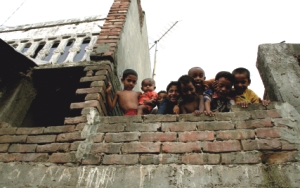 Without supervision, children often fall into danger |
“Children will always have scrapes and bruises, it's part of growing up. And sadly, we are never going to be able to prevent all injury deaths. But sometimes something so simple, such as putting the boti away in a high place after using it, could save a life.”
Dr Shafinaz says that on a national level, the BHIS has paved the way for injury prevention activities. The study, conducted in 2003, was the largest injury survey ever conducted at a community level in a developing country. Some 170,000 households, representing more than 800,000 people were surveyed in the joint study by the Government of Bangladesh, the Institute of Child and Mother Health, The Alliance for Safe Children (TASC) and UNICEF.
“This study helped Bangladesh to now be in a position to pioneer injury prevention programmes in developing countries,” Dr Shafinaz says. “It's shown us we have to do something to curb the injury toll now, obviously to save those thousands upon thousands of children, but also because if we do not address injury, Bangladesh will not be able to meet its Millennium Development Goal of halving under - 5 mortality.”
This has also been recognised by the Government of Bangladesh, with an injury prevention part in the Poverty Reduction Strategy Paper (PRSP) and in strategic plans across Ministries.
Meanwhile UNICEF, along with the Government, TASC and the Centre for Injury Prevention and Research Bangladesh (CIPRB), is piloting injury prevention projects, trying to find, as Dr Shafinaz puts it “solutions that are effective but also affordable and acceptable for our country's context”.
 Children are often engaged in domestic work that can lead to injury Children are often engaged in domestic work that can lead to injury |
UNICEF and its partners' injury prevention work includes setting up community crèches, providing Swim For Life classes, tracking incidences of injury, hosting “social autopsies” to discuss specific injury deaths and find ways to prevent them. The pilot project also aims to educate communities about safety issues. This could be through informal meetings with people in the courtyard and house-to-house visits. During these visits the project workers will emphasise the use of simple injury prevention tools like building mud-walls to serve as cooking barriers in rural villages, making sure children are well supervised at all times and putting boti and other sharp objects out of children's reach. The project is also trying to introduce first-aid and injury prevention into schools' curricula.
“It's a community approach,” explains Dr Shafinaz. “Mothers take their young children to the crèche, which is also a model safety home, while they are busy with their household chores. The kids can play in a supervised environment and mothers can finish off their jobs with peace of mind.” The BHIS shows nearly two thirds of mothers were doing household chores when their children drowned.
Later in the day parents might attend a community meeting about how to prevent child injuries, maybe learning how to make a mud barrier around the cooking area, or brainstorming ways to make their homes safer. Or perhaps they will take older children to the Swim For Life lessons.
Dr Shafinaz says the Swim For Life lessons, which receive technical support from the Royal Life Saving Society of Australia, are not about producing Olympic swimmers. The children are learning how to blow bubbles, stay afloat and swim to safety in ponds that are specially modified with bamboo fencing and a pontoon area.
A Swim For Life Community Swimming Instructor in the Raiganj area, Masood Parvez, volunteered to do this job to save lives in his community. “Many children drown in the rainy season and in boat capsizes, so everybody should learn to swim,” he says.
One of his star pupils, Sumaiya, 7, says she likes swimming because she can go fast. She looks confused when asked why she's taking Swim For Life classes. “Because I will not drown,” she explains. Her mother, Hafiza Khatun, has her son on a waiting list for lessons. UNICEF's Dr Shafinaz says there are not enough teachers or modified ponds to cope with the demand. Tragically, children like five-year-old Lima have drowned while on the waiting list for swimming lessons.
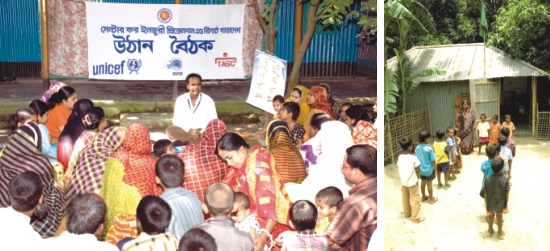
Educating the community about safety issues can save thousands of lives
Dr Shafinaz says these kinds of prevention activities could save thousands of lives like those of Lima, Hossain and Hassan. “Even if we could help reduce those 18,000 drowning deaths even to 17,000. That's 1000 fewer families who will be mourning the loss of their child.” And while prevention is always better than cure, Dr Shafinaz also says bringing first aid into school curricula and making sure people seek good health care will also lessen the burden of injury. “Many times the initial injury might not be so severe, but the lack of first aid or poor quality of care can mean a simple fracture could become cause for an amputation.”
This was definitely the case for Sohel, 10, who was playing outside after heavy rain back in June 2005 when he fell, broke his wrist and badly damaged two fingers. The family sought treatment from a local homeopath. Homeopaths are much cheaper than doctors and are more easily accessible in rural areas, but are also often quacks with no qualifications. This homeopath amputated two of Sohel's fingers during three months of treatment during which Sohel's wound got infected and his wrist froze at an angle. Later, getting treatment at a Dhaka hospital, a group of trainee doctors visited Sohel as a typical example of poor medical treatment and decided that there might be a chance for the arm to heal. Otherwise the 10-year-old would have to have his arm amputated.
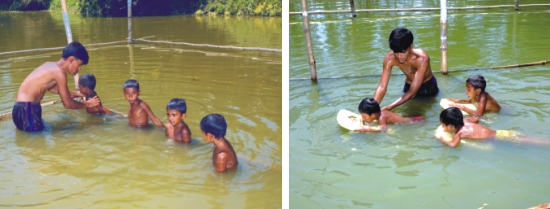
Educating the community about safety issues can save thousands of lives
“The pain is so great that I can't even cry any more,” says Sohel.
Double Drowning Tragedy
In one afternoon, Shajeda Khatun lost both her children. Her sons drowned in a pond that lies within 10m of their home.
Three months later, Shajeda could not answer how she was coping without her boys, Hassan, 10, and Hossain, 3. There were only tears. The villagers have pieced together what they think must have happened in the boys' final hours. They believe Hossain must have fallen into the pond and that Hassan then drowned trying to save his younger brother.
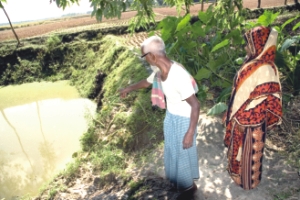 The ditch, a former quarry, lies immediately behind the village. It is off the side of a steep narrow path that takes the villagers out to the expanse of rice paddy fields. It's easy to see how one would slip, especially after rain. The ditch, a former quarry, lies immediately behind the village. It is off the side of a steep narrow path that takes the villagers out to the expanse of rice paddy fields. It's easy to see how one would slip, especially after rain.
Shajeda had been working out in these fields when she realised the boys had gone off. They searched and found the younger one first. A teary Shajeda says there was no hope in taking Hossain to a hospital, he was already dead. They started searching again for Hassan, thinking he was hiding, afraid his mother would be angry over Hossain's death. Hassan was found in water Shajeda says was as deep as a man's height. "They called the doctor. The doctor tried but said everything was finished."
The elder, Hassan, knew a bit of swimming, Shajeda says. "But not enough. If he knew swimming maybe he could have been protected; if he knew swimming he could have come to the shore," she says.
Shajeda could only describe their loss as a shock. "At the same time to lose two children together, there is no way to compensate this loss."
When asked how she was coping now, there were no words, only tears.
Himi
When Suraiya Huday's daughter Himi, 2, accidentally put her hand in hot ash last year, the burns were so severe her hands came out scorched and white. "But she didn't cry," Suraiya says. Himi is irritable as she sits playing on her mother's lap in their tiny village in humid heat.
Her right hand is now a stump. Her left, a claw.
"She can play with toys and do some small work using her left hand," mother Suraiya explains. Himi is one of the 3400 children left permanently disabled by burns every year in Bangladesh. A total of 170,000 children suffer from burns annually.
Suraiya says she was sitting with Himi one day in about April last year when Himi suddenly got up to play. The next thing Suraiya knew, her husband, Himi's father, Md Abdul Hamid Sheikh, was screaming that Himi had burnt her hand. "Normally the children don't go to the ash but unfortunately that day my child went there," Suraiya says. The ash had been left in an open area and had not been doused with water or sand.
Suraiya says she couldn't think clearly when she saw her daughter's charred hands. A neighbour helped take charge of the situation. "We didn't put her hand in water but brought her to a doctor."
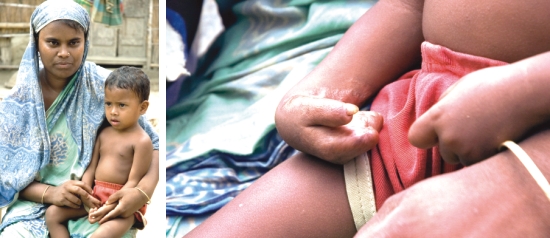
Both two-year-old Himi's hands were severely burnt when she put her hands in hot ash left out in the open
It's unclear whether the burns alone have left her permanently disabled, or whether early treatment has made it worse. "That (first doctor in the village) gave us some medicine but we didn't trust that doctor so we took her to Sirajganj." (The nearest big town, 30km away)
The child specialist in Sirajganj told them they had to come back every day. "Then we saw she was more sick, so we didn't go to Sirajganj, we went to the doctor in the village."
Suraiya says the burn treatment from the village doctor was better. She adds there is an enormous need for first-aid knowledge in the village. But even more important than first aid is prevention. Suraiya now tells her neighbours to make sure they don't leave ash lying around and that they should always put it out with water. People can also build barriers around cooking areas. Prevention is also far cheaper than the remedies, with the family paying 5,000 taka (US$75) on treatment so far. Surgery for Himi's left hand will cost 7,000-8,000 taka (US$100). There is no hope for the right hand.
Aside from the monetary costs, every day Suraiya and Himi are facing the emotional toll.
"If the children ask her, 'why is your hand like that?' She says my mother burned my hand," Suraiya says through tears. "If she says this when she grows up I won't be able to take it." Louise Russell is an Australian Government volunteer based with UNICEF Bangladesh
Copyright
(R) thedailystar.net 2006 |
